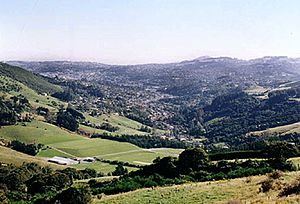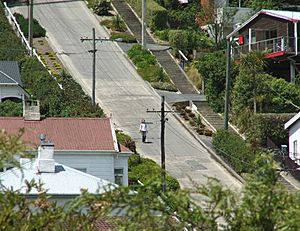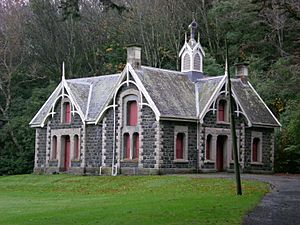North East Valley facts for kids
Quick facts for kids
North East Valley
|
|
|---|---|
|
Suburb
|
|
 |
|
| Country | New Zealand |
| Local authority | Dunedin |
| Area | |
| • Land | 468 ha (1,156 acre) |
| Population
(June 2023)
|
|
| • Total | 10,150 |
|
|
||
North East Valley (sometimes called Northeast Valley or just NEV) is a cool suburb in the city of Dunedin, New Zealand. It's known for its unique geography and friendly community.
Contents
Exploring North East Valley's Location
North East Valley is nestled in a valley carved by the Lindsay Creek. This creek is a small stream that flows into the Water of Leith. The suburb is surrounded by hills like Pine Hill and Signal Hill. It's only about 3 kilometers (1.9 miles) northeast of Dunedin's city center.
Homes and Students in NEV
This area is mostly a place where people live. You'll find a mix of older residents and lots of students here. These students attend the University of Otago and Otago Polytechnic. Both of these schools are about 1 kilometer (0.6 miles) south of the valley. They are just past the beautiful Dunedin Botanic Gardens.
The main street in North East Valley is called North Road. Many smaller streets branch off from it. Some of these side streets, especially on the Signal Hill side, are super steep! One of them, Baldwin Street, is even famous for being the world's steepest street. Other important roads in the suburb include Blacks Road and Norwood Street. North East Valley used to be its own town until 1910. That's when it joined up with the city of Dunedin.
Different Parts of North East Valley
The name "North East Valley" can sometimes mean a bigger area. This larger area includes four smaller neighborhoods within the valley. But more specifically, "North East Valley" refers to the part from Chambers Street up to Chingford Park. Beyond this main part are two smaller living areas: Normanby and Mount Mera. The area below Chambers Street is often called The Gardens or The Gardens Corner. This is because it's close to the Dunedin Botanic Gardens.
Normanby and Mount Mera Explained
Normanby is the very northern end of North East Valley. Here, the city buildings start to give way to open countryside. The land in Normanby is very hilly. It sits at the base of Mount Cargill. The slopes of Mount Cargill are covered in thick forests. You can find many walking trails there. Some of these trails begin at the Bethune's Gully reserve, which is at the northern tip of Normanby. Mount Mera is a neighborhood with state-built homes. It's located on the sunny, north-facing side of the valley, just above Normanby.
North Road: The Main Street
North Road was once the main way to travel north out of Dunedin. It starts at the Gardens Corner. Here, it connects with Opoho Road and Bank Street. Bank Street then links up with the northern end of Dunedin's main street, George Street. At this corner, there's a sports field called the Gardens Ground. It's used for cricket and football games. The Dunedin Northern Motorway, which is part of State Highway 1, also begins just past this ground. The Gardens Ground is the home field for the Northern Football Club and the North East Valley Cricket Club.
From the Gardens Corner, North Road goes pretty straight for about 2 kilometers (1.2 miles). It crosses the Lindsay Creek and keeps going northeast. Blacks Road, a very steep road that leads to the suburb of Opoho, branches off North Road. This is near the widest part of the valley. After Chingford Park, the part of the road with houses ends at the junction with Norwood Street. From there, North Road starts to climb and wind around the end of the valley. It then goes through farmland, connecting to roads that lead to Port Chalmers and Waitati. Before the Dunedin Northern Motorway was built, this was a very important route out of Dunedin to the north. Now, it's not used as much.
Famous Spots and Landmarks
Besides Baldwin Street, North East Valley has several other cool landmarks.
University Colleges and Buildings
Two university dorms, Knox College and Salmond College, are on the lower hills east of the Gardens Corner. Another dorm, Aquinas College, is on the lower slopes of Pine Hill to the west. Near Aquinas College is a noticeable building that used to be the Santa Sabina Convent. You can see it from many parts of central Dunedin. Another important building in the valley is Ross Home. It's one of the city's main homes for older people and is located on North Road.
Parks and Green Spaces
The suburb has several great parks and gardens. These include Chingford Park, the Quarry Gardens, Forrester Park, and Bethune's Gully.
Chingford Park: History and Fun
Chingford Park is a fun place to visit. It has old stone stables that are full of history. The park is at the northern end of North Road. It used to surround a house called Chingford House, which was built in 1862 but isn't there anymore. A businessman named P.C. Neill (whose family includes actor Sam Neill) built and designed the property in the 1870s and 1880s. He added many things, including the historic bluestone stables built in 1880. These stables are still there and are a central part of the park. Chingford Park is popular for walking. It also has fields for soccer and cricket, and the city's main archery club. You can also see several giant Macrocarpa trees near the Lindsay Creek in the park.
Quarry Gardens: A Transformed Space
The Quarry Gardens are a special park made from an old rock quarry called Palmer's Quarry. It's on North Road, right across from the bottom of Baldwin Street. The quarry closed in 1980. Then, starting in 1989, it was completely transformed into a beautiful terraced garden. The old quarry pit is shaped like an amphitheater. It has been used for outdoor music concerts, especially in the late 1990s. Several walking paths go up to the different levels of the old quarry. These levels are now filled with many kinds of plants, especially rhododendrons. Other paths follow the banks of the Lindsay Creek. These connect to Selwyn Street to the south and Watts Road to the north. The gardens are owned by a private group, but everyone is welcome to visit them all year round.
Forrester Park and Bethune's Gully
Forrester Park is a sports area at the end of Norwood Street. It has fields for football and rugby, and a BMX bike track. There's also a dog park and a kennel club there. Bethune's Gully is also reached from Norwood Street. It's a quiet reserve that covers about 86 hectares (212 acres). It sits at the very bottom of Mount Cargill and is a popular spot for beautiful scenery. From here, walking trails go up the slopes of Mount Cargill. The reserve was originally where sawmills and brick factories operated in the 1880s. The city council took ownership of it in 1955.
People of North East Valley
North East Valley covers an area of about 4.68 square kilometers (1.81 square miles). As of 2023, it has an estimated population of about 9,342 people. This means there are around 1,996 people living in each square kilometer.
In 2018, the population was 9,342. This was an increase of 684 people since 2013, and 909 people since 2006. There were 2,757 homes. The population included 4,398 males and 4,953 females. About 7.3% of the people were under 15 years old. A large group, 61.9%, were aged 15 to 29.
Most people in North East Valley are of European descent (81.5%). There are also people of Māori (10.2%), Pasifika (3.5%), and Asian (12.4%) backgrounds. About 26.4% of the people were born outside New Zealand. Many people (58.3%) said they had no religion. About 27.1% were Christian.
Many people in North East Valley have gone to university. About 23.3% of people aged 15 or older had a bachelor's degree or higher. About 24.5% of people aged 15 or older worked full-time, and 21.9% worked part-time.
Schools in the Valley
North East Valley has two primary schools:
- North East Valley Normal School is a state primary school for students in years 1 to 6. It has about 223 students and opened way back in 1851.
- Sacred Heart School is a state-integrated Catholic primary school for years 1 to 6. It has about 118 students. It started in 1895 at Sacred Heart Church and moved to its current spot ten years later.
Both schools welcome both boys and girls.





